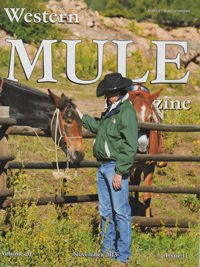 Trail Snacking and Reforming the Monster I Created
Trail Snacking and Reforming the Monster I Created
A great trail ride on a summer or fall day; heading out to the nearest trailhead, letting the sun warm you, and enjoying a terrific ride with your mule; what a day! Until your mule decides he’s hungry on a sketchy bit of trail and you lose count of how many times he’s yanked the reins from your hands in an unending tug of war.
I’ve been there as have many other riders. At best it’s a hassle and at worst can be downright dangerous. I used to allow the equine I belong to, LT, to grab a bite whenever he wanted. After all he was working hard to haul me around why not let him grab a quick bite? Things changed when I started riding on the sides of mountains in the Cascade Range where it was vitally important for LT to pay more attention to where he was placing his feet than on that tempting sprig of grass just off the trail. Clearly our expectations were diverging on the topic of appropriate times and places to eat. I’m sure that many of us reading this column have faced similar situations.
Correcting this disconnect between your expectations and the reality of the situation requires us to consider what kind of training, if any, that we’ve done with our mount.
What kind of trail riding education has your mount gone through? Is your mule a distinguished graduate student of the trail riding academy or is he a remedial student? Mules and horses go through rigorous training programs for arena jobs but often we expect our mounts to just “know” how to handle the trail.
When they don’t perform flawlessly we get frustrated and upset because we don’t understand that horses and mules need to be taught trail riding just as they’re taught any other equine activity, from roping and eventing, to dressage and beyond. There are many good reasons why experienced riders start with ground work and then introduce a new animal to the trail ponied to a veteran mule. Only after many hours and miles, of school, will the new kid graduate to a full-fledged trail animal ready to take a rider safely into the back country and back.
When we train for the rigors of the trail we battle against the equine’s prevailing nature that helps mules avoid danger and preserve their status within the herd. While we may not be able to completely eliminate these innate behaviors we aim to teach our mounts to endure the unnatural events that they’ll encounter, to listen to our requests, and to relax and enjoy the job of traveling down the trail safely and efficiently.
For many mules and horses, grazing is to them what chocolate is to us; irresistible. You really can’t blame them. Equines are grazing animals designed to eat small amounts of grass on a continual basis. However, this rational doesn’t make your trail ride any more pleasant as the reins are pulled from your grasp time and time again. So the objective becomes how to arrive at a working compromise between human and mule so each of us can achieve our goals.
For any compromise to work we have to be reasonable. Equines love fresh grass; after all it is their natural food. We should understand that grazing on the trail is a very natural urge for them to want to do. Trail snacking isn’t rude or bad; it’s their version of chocolate. I don’t expect LT to understand that a saddle equals no food. If that were to happen I doubt that he’d continue to run to gate when I hook up the trailer. Instead, what we as trail riders can do is to teach our mounts a grazing cue that means “OK, here and now is a great place to graze”. For LT and I that cue is lowering the reins and a pat on LT’s neck.
Teaching LT that loose reins and a pat means it’s ok to eat took a little while, after all there’s no free lunch so to speak. But it paid off in rides that became much more enjoyable as well as saving a lot of time, effort, and arguments along the way.
The steps I took in LT’s grass grabbing re-education included making the “right” choices easy for him. Don’t stand your beast in the middle of a meadow and expect it not want to taste that choice grass. Instead, start this training program where the graze is marginal at best and slowly work your way into more tempting locations.
LT’s re-education also required me to concentrate on my level of awareness. How many of people are riders and how many are passengers? Just as our mounts need to be aware of their surroundings, so must we be aware of our mount. A rider is aware of everything that is going on, and so can make changes or corrections before problems occur. A passenger is just cargo for the mule to pack. Don’t be cargo; be attentive to your mount and what he’s thinking and re-direct his thoughts before he dives after that equine version of trail chocolate.
We’re getting into the time of year that is perfect for re-educating our mounts as well as ourselves. Winter is a wonderful season to work on concentrating on our mounts. Many of our favorite areas are snowed in; use these restrictions to focus on teaching you and your animal how to be the very best trail team.
As always for more trail riding tips visit www.TrailMeister.com not only are we the largest directory of equine trails and camping areas in North America. We’re also the official trails directory of the North American Trail Ride Conference and the Back Country Horsemen of Washington.


